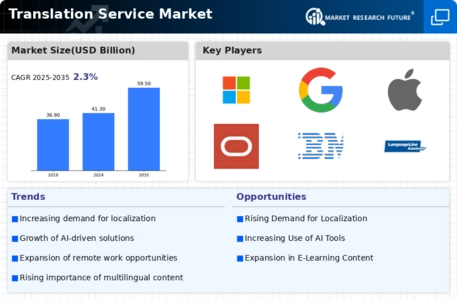Market Trends
Key Emerging Trends in the Translation Service Market
The business is seeing a shift away from human translators and towards machine translation (MT), as MT is an effective technology that can produce identical linguistic conversion at a much reduced cost and time. It is anticipated that new implementation strategies, such as crowdsourcing, together with advancements in MT technology would lower MT costs while increasing its effectiveness. Language service providers are quick to use this technology since it allows them to correlate and improve output.
Additionally, service providers may expand by employing big data for social media data mining to learn more about businesses and goods. Decisions about marketing must be made using this translated data. The field of machine translation (MT) has expanded due to the development of translation theory that produces minimum mistakes and grammatical consistency. The past several years have seen an increase in the sector due to the quick and affordable translation of documents into regional languages. Additionally, a number of multinational corporations employ this technique since it is economical when creating multilingual material for their international websites. The accuracy of translated content can be improved by hiring qualified linguists to conduct post-editing for information that has been machine-translated. The growing combination of machine translation (MT) with artificial intelligence (AI) is a notable development in the translation services business.
Artificial intelligence (AI)-driven translation technologies are evolving, providing more efficient and economical solutions. These technologies not only improve translation speed but also accuracy, particularly for large-scale or repeated text. It's crucial to remember that, even if MT and AI are useful tools, human translators are still required for complex and culturally sensitive translations. An other noteworthy development is the increasing focus on localization. Companies are realising that understanding cultural quirks and overcoming language obstacles are necessary for effective communication. Content must be localised to accommodate the language, cultural, and geographic preferences of certain target audiences. The need for translation services that involve cultural adaptation in addition to language conversion is growing as firms expand internationally. This pattern indicates a calculated method to successfully interact with a variety of markets.
The market for translation services has also been influenced by the growth of remote work and virtual collaboration. Modern teams and clients are dispersed across several geographic regions, making smooth communication essential. In an increasingly globalised workplace, translation services are essential for correctly communicating ideas across linguistic boundaries and facilitating productive teamwork. This trend is probably going to continue as many organisations still use remote work as a common operating model. The market for translation services is seeing developments driven by changing customer expectations.
Both consumers and businesses today demand quick turnaround times without sacrificing quality. In order to keep up with this trend, translation service providers are using technology, streamlining workflows, and putting in place effective project management procedures. Fulfilling these elevated standards is turning into a competitive differentiator in the marketplace.










Leave a Comment